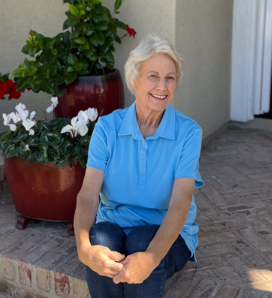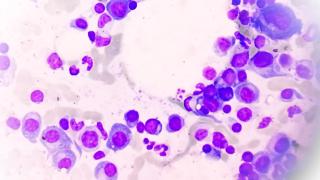It’s hard to rattle Julie Hilberg.
She’s a retired schoolteacher and principal with 32 years in the educational trenches. Controlling a class of second-, third- or fourth-graders and handling the clashing needs of a beleaguered teaching staff is not for the faint of heart. Hilberg loved it all.

“I enjoy seeing how the kids grow,” she said in her typically steady, low-key voice. “And I was able to have a large impact on a large number of kids and their teachers.”
People who meet her see the calmness right away.
“She’s very easygoing, someone who rolls with the punches,” said Amrita Krishnan, M.D. , executive medical director of hematology at City of HopeÒ Orange County and director of the Judy and Bernard Briskin Center for Multiple Myeloma Research. Krishnan has been treating Hilberg for more than a decade. “She just doesn’t get too anxious,” she said admiringly.
Good thing, too, because for much of her life Hilberg has been battling a cascade of medical challenges that could easily overwhelm many people.
Growing up in Long Beach and later Rancho Cucamonga, California, Hilberg remembers a fairly normal childhood, “playing in the neighborhood, running around, doing school sports.” She picked up a few extra dollars at Disneyland, working nine years in the China Closet shop. She picked up something else there, too. “I met my husband at Disneyland!”
A Thyroid Cancer Diagnosis
Now 71, Hilberg says the health challenges began in her 20s when she started gaining weight, eventually reaching 215 pounds. “I was a sugar addict,” she recalled. At first her obesity didn’t significantly affect her lifestyle or mobility, but as many doctors will tell you, it put her at risk for other diseases, including type 2 diabetes and several types of cancer.
Her first cancer battle came a decade later, in 1989, when she noticed a growth in her neck. Her doctors monitored it for several years, but it kept growing. Ultimately, they diagnosed Hilberg with thyroid cancer. She had surgery to remove the thyroid and parathyroid glands, followed by radiation to eliminate any remaining cancer cells. Losing the parathyroid can cause low calcium levels, so Hilberg has been taking calcium supplements ever since.
Facing Multiple Myeloma
Everything seemed fine afterwards until the spring of 2010, when Hilberg noticed some unusual discomfort.
“I was working in the yard and I felt this pain in my chest, so bad that I couldn’t lie down,” she recalled. The doctors thought she might have torn a ligament. No one suspected anything more serious. But the pain worsened month by month, and by December Hilberg says what now felt like “bone pain” sent her to the hospital for a battery of tests. The results came as a shock.

“They found advanced bone lesions and holes,” she recalled. Hilberg had multiple myeloma, a cancer of the plasma cells that causes bones to break down. And, the doctors said, it was terminal.
This time the easygoing demeanor disappeared.
“I’d had cancer before,” she said, “but hearing ‘terminal’ really sets you back.”
It also propelled her into action.
She knew City of Hope by reputation — a friend had been treated there. So Hilberg and husband Robert did the ultimate “cold call” — they simply walked in. They gathered up their medical paperwork, drove to the Duarte campus and spoke with a nurse who explained that the case would be put before the doctors, and it could take a week before someone responded.
Krishnan called the very next day. Her message to Hilberg: You need to be hospitalized.
“We try to get people in quickly, for sure,” said Krishnan. “We understand how stressful that diagnosis can be.”
Swift Myeloma Treatment
There is never a “good” time to get cancer, but Krishnan, a world leader in multiple myeloma research, impressed upon Hilberg just how fortunate she was. Never once uttering the word “terminal,” Krishnan explained how an explosion of promising new drugs was taking place. As a result, “survival rates have more than doubled,” Krishnan said. “There are many new options, and you can see what’s coming. I’m very optimistic.”
That “explosion” continues today: More than a dozen new myeloma treatments, including two using CAR T cells — the patient’s re-engineered immune cells — have emerged in the last decade, three in the last year alone.
Krishnan started Hilberg on the targeted therapy drug Velcade (bortezomib), approved by the Food and Drug Administration (FDA) just a few years earlier. “It was novel at the time,” said Krishnan. “It’s standard of care now.” Velcade is a so-called proteasome inhibitor. It blocks the action of specific protein complexes that some cancer cells need to survive.
The goal was to bring Hilberg’s myeloma cell count down low enough to make a stem cell transplant possible. There were a few bumps in the road. It took a month longer than expected to reach that level. The aggressive chemotherapy that precedes any transplant caused nausea and hair loss. Hilberg also needed a surgical procedure called kyphoplasty, in which cement is injected to repair a damaged vertebra. She also had to fend off two bouts of post-transplant pneumonia, when immunosuppressant drugs left her vulnerable to infection.
Nevertheless, the transplant went extremely well, and it succeeded beyond expectations, keeping Hilberg essentially free of myeloma for nine years (six is about the average). When the myeloma began to reassert itself, Hilberg resumed her biweekly Velcade infusions, which continue today. Through it all, Hilberg displays her usual even-tempered aplomb.
“I don’t worry about myeloma,” she said. “I just let Dr. Krishnan worry about it. She’s wonderful. Wherever she goes, I’ll go.”
Managing Type 2 Diabetes
But Hilberg had something new to worry about. Still dealing with obesity, and still getting monitored regularly by an endocrinologist because of her old thyroid cancer, in 2020 Hilberg began to display signs of type 2 diabetes. Before long, that endocrinologist — Ping H. Wang, M.D. , professor and chair of the Department of Diabetes, Endocrinology & Metabolism — would be called upon to stabilize Hilberg’s blood sugar and find a way to help her lose weight, all while keeping a close eye on her ongoing myeloma, because one can affect the other.

“It’s a unique clinical situation,” said Wang. “Obesity can increase the risk of multiple myeloma and also affect long-term survival. Diabetes has also been linked to lower myeloma survival rates. And some myeloma treatments, like Velcade, can increase blood sugar.”
In other words, Hilberg’s case required walking a medical tightrope, balancing all her challenges and making sure that treating one didn’t make another worse.
In such a case, Wang says, you don’t treat sequentially — rather, “we do everything. We must act aggressively against the myeloma because the consequences of not treating are not good. And we must control her high blood sugar because it can cause acute problems” including heart attack, stroke and damage to the kidneys, eyes, gums, feet and nerves.
“The goal was to optimize her care. To watch out for everything and act accordingly,” he said.
In this regard, Hilberg was fortunate yet again. City of Hope is uniquely positioned to treat both cancer and diabetes, with world-class clinicians caring for patients and researchers engaging in groundbreaking clinical trials.
“With our unique expertise in both diseases,” said Krishnan, “it’s to her [Hilberg’s] advantage to be on the cutting edge of each.”
Krishnan, Wang and their respective staffs collaborate closely on Hilberg’s treatment. For example, Wang prescribed the newly approved injectable diabetes drug Mounjaro (tirzepatide) to lower Hilberg’s A1C levels and help her lose weight. (Mounjaro is not yet FDA-approved for weight loss, but Wang expects that to happen soon.) Combining that drug with diet and exercise, Hilberg has dropped 84 pounds, an astonishing result with important repercussions for her cancer treatment. Her Velcade dosage is weight-based, so immediately Krishnan adjusted the amount that Hilberg now receives. “It’s a team effort,” said Krishnan.
It’s a winning team. Krishnan happily says Hilberg’s myeloma is “well-controlled,” while Wang reports her A1C is “now in the normal range.”
As for Hilberg herself, she’s glad she didn’t accept that original “terminal” diagnosis.
“At City of Hope,” she says, “they always say, ‘We can do better.’ When I’m there, I never feel hopeless. The doctors, the nurses, the entire staff, everyone is positive, upbeat and hopeful, and it rubs off on the patients.
“When you’re in such a caring organization, how could you not do well?”
Main photo: Myeloma cells crowd out normal cells in the bone marrow.
